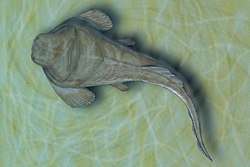Heterosteus
| Heterosteus | |
|---|---|
 | |
| Life reconstruction of Heterosteus ingens | |
| Scientific classification | |
| Kingdom: | Animalia |
| Phylum: | Chordata |
| Subphylum: | Vertebrata |
| Infraphylum: | Gnathostomata |
| Class: | Placodermi |
| Order: | Arthrodira |
| Suborder: | Brachythoraci not Gross, 1932 |
| Family: | Heterosteidae |
| Genus: | Heterosteus Asmuss, 1856 |
| Species | |
| Synonyms | |
| |
Heterosteus is an extinct genus of heterosteid placoderm known from remains discovered in Europe and Greenland.
Description
This genus includes the largest species in the family, and are among the largest arthrodires, as well, with the type species, H. asmussi, having an estimated body length of up to 6 metres (19 ft 8 in).[1] The genus differs from Herasmius by having the orbits on slightly longer eyes talk-like projections. The various species are found in Givetian-aged deposits in Europe and Greenland. With the except of the German H. rhenanus, all species are known from freshwater deposits: H. rhenanus is based on fragments found in a marine deposit.
References
This article is issued from
Wikipedia.
The text is licensed under Creative Commons - Attribution - Sharealike.
Additional terms may apply for the media files.